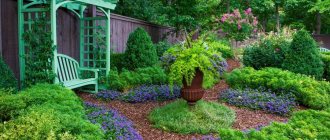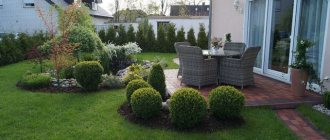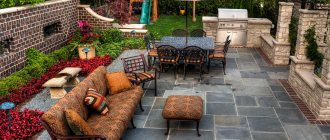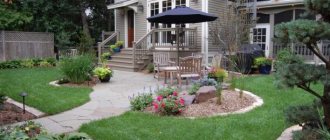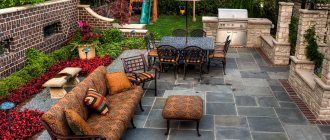Visually separate the garden and vegetable garden.
Zoning the space in the garden will help you create a more holistic and harmonious design. A flowerbed with tall ornamental grasses and flowers serves as a kind of partition between the vegetable garden and the garden.
And although the garden is located very close to the vegetable garden, separated by such a decorative border, it will turn out to be more cozy and beautiful.
Making an inexpensive raised bed
The cheapest way to build raised beds is to fence them with fences. Among other things, such beds will be an ideal decoration for a site designed in a natural style. Here you can grow not only vegetables, but also flowers. As noted above, the arrangement involves multi-layer filling. Let's look at its simplest example.
Table. Instructions for arranging budget warm beds.
| Steps, photo | Description of actions |
Step one | Cover the soil inside an already made wicker fence with ordinary cardboard or geotextile - this way, beneficial substances will not go into the ground during watering. There is no point in talking about the durability of cardboard, but the good thing about it is that cellulose will also become organic in the future. |
Step two | Place a layer of weeds from the garden or freshly cut lawn grass on top of the cardboard. |
Step three | Then add dry hay. |
Step four | Place a layer of compost or, alternatively, rotted leaves on top of the hay. |
Step five | And the last layer is fertile black soil. |
Step six | The optimal time for arranging such beds is autumn, because after summer all the necessary components will be available. By the way, if necessary, you can take care of natural heating of the soil - for this you need to make a thin layer of manure (the latter will overheat and release heat). |
Video - Making universal warm beds
Consider the view from different parts of the garden.
It's beautiful to admire your garden from afar, but it's much more important to enjoy it from the inside. Therefore, the views that open both from your gazebo and from a path or secluded bench in the garden are important.
To create an interesting structure, use curved paths and arches with climbing plants in the garden, carefully fitting them into the general arrangement of shrubs and fruit trees.
It is important to take into account not only the beauty of flowers, but also their aroma, then, walking through the garden, you will be able to feel how the aroma of roses flows into the wonderful aroma of jasmine or lilies.
Choose “convenient” trees
Caring for an orchard requires not only time, but also certain knowledge, skills, and abilities. To simplify and reduce worries about the garden, it is recommended to adhere to a certain strategy at different stages of cultivation.
How to simplify the care of garden trees:
- Low growing varieties. The smaller the height of the tree, the easier it is to care for. A large pear or apple tree is very difficult to maintain; you have to use a stepladder to perform various tasks. In a garden of dwarf and columnar fruit trees it is easier to: spray;
- perform pruning (in the indicated types it is kept to a minimum) - standing on the ground, you can trim any branch;
- to collect fruits - you don’t have to climb ladders and use fruit pickers.
Use any corner of your garden as a flower garden.
Your garden is not just a place of struggle for the harvest. With a little effort, you can always give it a more interesting look - by planting herbs or flowers that repel insects as a border.
Even small corners of the garden, such as the area at the back of the house, can be used to create a cute flower garden with unpretentious perennials.
A fence is an excellent place for a flower garden with garden vines; it is enough to strengthen the garden net on it. For the sunny side of the fence, you can plant a climbing rose that will bloom all season.
For a shady place, plant honeysuckle, which blooms, although not for long, but has a very pleasant aroma.
And, of course, use clematis! This is the most popular garden vine that can transform your garden in an absolutely stunning way. Moreover, clematis will feel best on a garden arch, because... it needs shade in the root zone and light for shoots.
A garden is not only a decoration, but also, mainly, a harvest. Using grapes to entwine a garden gazebo, we will solve two problems at once.
Firstly, grapes will create a pleasant coolness on a sunny day, and secondly, in the fall they will delight us with a generous harvest.
Use new types of fertilizers
Whatever crop you take, it has its own fertilizer application schedule. Gardeners and gardeners have to apply fertilizers from early spring to late autumn, either for fruit trees, or for tomatoes, cabbage, berries, etc. APION, “fertilizer for the lazy,” helps solve the problem.
The abbreviation “APION” stands for: Automatic Feeding Osmotic Pump. Any plant is a biological pump that consumes nutrients from Apion.
What is APION and how does it work:
- This is a tablet or small packet. They bury it in the ground so that they can forget about feeding for a year and a half.
- Inside the semi-permeable shell there are soluble fertilizers and biostimulants for growth.
- The validity period varies from several months to 1.5 years.
- Fertilizers are dosed evenly, reaching the roots of the plant in the required quantities throughout the growing season.
Shade-loving and light-loving plants can be planted side by side.
In any corner of your garden you can combine your favorite plants, creating the lighting regime they need.
It is important to give light-loving tall plants a sunnier side, perhaps even removing some of the shading tall plantings, and plant shade-loving plants nearby in their shade.
Sow seeds in autumn
Experienced gardeners know that a large number of garden crops can be sown/planted in the fall.
Advantages of autumn planting:
- In the spring, time is freed up - during this period, gardeners have enough worries related to sowing and planting work.
- Everything that is sown in the fall begins to grow vigorously in the spring, outstripping plants sown/planted after the end of winter. It is possible to obtain earlier harvests.
In the fall, you can sow dill, carrots, cabbage, beets, various flowers for the garden - asters, marigolds, calendula and many others. It is also convenient to plant bulbous crops before winter - garlic and onion sets.
Create a luxurious look.
Don't be greedy and don't plant every beautiful variety of flower that catches your eye in your garden. It’s better to choose 1-2 beautiful varieties, but create a truly luxurious flower bed from them by planting several bushes nearby.
It is important to learn how to grow very few plants - so for this arch near the gate, two varieties of climbing roses were chosen, but these are, indeed, healthy and well-groomed bushes that produce abundant flowering.
Install modern greenhouses
Many gardeners have their own greenhouse on the site, in which they grow seedlings for open ground or grow heat-loving crops in them - tomatoes, cucumbers, etc. Traditional greenhouses are film. The transparent covering material is simply pulled over the arches.
To facilitate and simplify the process of growing indoors, it is recommended to abandon outdated structures and install more modern polycarbonate structures on the site.
Choose a greenhouse model with an automated irrigation, ventilation, and temperature maintenance system. This will save a lot of effort and time, and at the same time provide ideal conditions for plant growth.
Add contrast.
Where there is no interesting structure, use color. The mint thickets in the far corner of the garden do not have a particularly interesting aesthetic appearance. By adding a container with contrasting foliage to these plantings, we got an excellent result.
Moreover, contrast can be not only color, but also light. So white flowers in a shady corner of the garden will visually make it less gloomy, giving it an almost mystical charm.
Mix it up.
A beautiful garden with your own hands means creating an informal, relaxing atmosphere. This can be achieved by using a combination of plants in the garden in the most unexpected way.
By adding a few simple flowers alongside your vegetable plantings, you can transform a simple vegetable garden into a triumph of nature's beauty and bounty in your garden.
Do you agree that a good harvest brings no less aesthetic pleasure than a flower garden?
And enjoying the taste of homemade vegetables is another gift from nature for us.
Good harvests with raised beds
Constructing a frame and watering high beds is a very labor-intensive (at least at first) process, which, however, in the future will help you forget about bad harvests or an unfavorable climate.
Aluminum barrels and containers of suitable shape are a good and easy-to-transport material for creating high beds
Beds fenced with stones
The sun always illuminates the high bed well, and therefore the soil in it warms up enough to begin planting in April. A metal mesh laid underneath will protect the plants from rodents. If the frame is not very wide (no more than 1.5 meters), then it will be convenient for you to care for the plantings on both sides. You can also divide the bed lengthwise into two strips and cover it with film to make a kind of greenhouse.
Raised beds
You can also try growing high beds with fragrant herbs in urban areas
Note! It is these beds that allow you to get the earliest harvest - first salads, and later vegetables. There is only one drawback of this design - the need for frequent watering. The fact is that water does not stay in such soil for long.
A raised bed, despite the initial difficulties with arrangement, will still quickly pay for itself and give good results. Besides, she looks quite attractive.
The smart bed for fragrant herbs only needs to be dug once, before planting the seedlings
Smart free-form bed
Use unpretentious plant varieties.
Do-it-yourself gardening involves organically pure products, preferably with minimal use of chemicals.
And the best way to avoid chemicals is to choose disease-resistant varieties.
Before bringing a new plant to the site, inquire about its resistance to diseases and pests so that it does not create problems for you or the surrounding plantings in the garden or vegetable garden. This applies to both vegetables, fruits and flowers.
You can always find those varieties of plants that will grow well in your conditions, without requiring increased attention or the use of chemicals from you.
Stop weeds from growing
Weed control has always taken a lot of effort and time. This is completely unproductive work aimed at destroying a factor that impedes the normal growth of cultivated plants.
The traditional way to destroy weeds is by hand weeding with a hoe. The beds have to be treated every 2-3 weeks, since weeds quickly grow from the rhizome, plus new ones appear from seeds scattered throughout the garden.
How to prevent weed growth:
- Use herbicides. There are drugs with continuous and selective action. The former destroy all weeds, the latter act against certain species. Popular herbicides are Roundup, Tornado, etc. With the help of herbicides, it is possible to cope with such tenacious weeds as wheatgrass, cow parsnip, and hogweed. Use the products according to the instructions indicated on the packaging.
- Cover the beds. To prevent weeds from growing, cover the beds with an opaque material. Black film, agrofibre or regular cardboard will do. Make slits in the material in which plants will grow. To make the beds look prettier, the film can be sprinkled with sawdust, hay, and straw.
- Sow green manure. After harvesting, weeds grow vigorously in the vacated area.
To prevent them, sow the area with rapeseed, rye, and white clover. They prevent the growth of weeds by saturating the soil with glycosides that inhibit the growth of harmful plants. Green manure is an excellent fertilizer. 3 weeks after sowing, dig up the area, embedding the greens in the soil to a depth of 3-4 cm.
Agrofibre, unlike film, “breathes”. This is a lightweight material, strong and resistant to natural influences. No condensation is created under it, so the development of fungal diseases is not provoked.
Everyone has their place.
Every corner in the garden has its purpose, has the right to exist and your love.
Therefore, a compost bin and a shed should not be grimy foundlings in your garden, but be as loved and cared for as flower beds and a vegetable garden.
In return, every corner of your garden will only delight you.
Think big.
When creating a garden with your own hands, it is important to plan plantings not only on a plane, but to use the height difference - then your landscape design will be more rich and interesting. In this regard, those who have a garden on a slope are lucky - if there are certain problems, such a garden will always look better than flat plantings with a vegetable garden and a couple of fruit trees in the corners.
For those who have a flat garden plot, arches and pergolas will come to the rescue, which will turn your garden into a fairy-tale place. It's also a great way to show off your beautiful climbing roses and clematis.
The question often arises about how to cover climbing roses for the winter. In fact, you make a minimum of movements - you cover the roses with film directly on the arch.
Vegetable garden as a place for creativity.
While it may be too late to make any changes to your garden this year, it's never too early to make quantum leaps towards a better garden in the future. Analyze what your garden looks like now, what you would like to add, remove or change. Draw a plan.
Think about where the gaps are, where are the mistakes? Is your garden not as luxurious as you would like?
Visually, fewer varieties in one place create a greater effect. Plant only one type of vegetable in the beds - then it will look denser.
Surprise yourself. Always try one or two new ideas per season.
Do your best. Don't give up because your space or time is limited. Start small - plant something that inspires your admiration.
It is true that they say that the most delicious vegetables and fruits are those that grow in our garden. A DIY garden will give you more satisfaction in life than anything else.
Lazy beds - a modern trend
If you want to become more independent from annoying gardening chores, then you can master the technique of creating lazy beds that allow you to enjoy your time at the dacha as much as possible and do not require regular weeding. Moreover, beds for the lazy are not only very convenient - they also increase the productivity of garden crops!
The easiest way to build smart beds is on a flat surface
Seedlings in a high bed always receive enough sunlight
Summer residents know very well how much attention and effort each planted plant requires, and the results do not always justify the costs - for example, seedlings may not germinate or, alternatively, may not produce the desired harvest. And arranging lazy beds is one of the possible solutions to this problem.
Multi-level narrow beds and paths sprinkled with pebbles
Small beds you can make yourself with a minimum of tools
What is special about such beds? First of all, the seedlings grow “on their own,” but the yield increases several times. The technique is based on one simple rule: beds cannot be weeded or dug, except for their preparation and immediate planting. Yes, constant weeding helps get rid of weeds and fluff up the soil, but sooner or later the soil will dry out and stop providing the plants with enough moisture.
Stone fences are an easy way to build a foundation for a garden bed on uneven terrain.
Compact beds in urban areas
Raised beds with trellises on a gravel plot
Note! Preparation in this case is very important - it is recommended to carry it out in the fall, because then it is possible to collect mulching material (the ground can be covered with cones, straw, sawdust). If there is such a cover, weeds will not be able to germinate in the area.
The process of making a lazy bed itself is not complicated and consists of a few simple steps.
Step 1. First, decide what the height of the sides of the bed will be (it depends on the place where you will install them). In accordance with the required dimensions, cut the boards for the sides, connect them using self-tapping screws and wooden blocks (at the corners). It is advisable to use clamps, as in the image below. Once assembly is complete, turn the finished box over and mark a location for it based on lighting conditions.
Construction of a bed box
Step 2. Dig holes 12-15 cm deep under the corner bars, firmly install the bed. Check the sides using a building level (so that the irrigation system functions normally in the future). Attach sections of PVC pipe to the sides from the inside for subsequent installation of film or hoops with mesh. Compact the bottom of the bed, cover it with a fine-mesh metal mesh (it will protect the plantings from rodents), as well as a layer of geotextile (the last point depends on the purpose and materials of the bed).
Installation and arrangement of beds
Step 3. Fill the box with soil and secure the hoses for the drip irrigation system. Plant the seedlings. If necessary, install arcs for covering material. That's it, the lazy bed is ready to use!
Photo of soil mulching
Mulch is also useful for filling the areas between the beds.
Some more useful tips
- You definitely need to take care of the irrigation system. It may not be the most expensive model. Watering can be done infrequently, but abundantly - this way the plants will receive enough moisture until your next visit.
Automatic watering system
To prevent the soil from creeping out of the beds fenced with stone, you can use strips of geotextiles
- Properly selected garden tools can be the key to saving time and effort. Therefore, buy only high-quality tools - not only buckets and shovels, but also other useful little things that make your work easier. Also, think in advance about how this inventory will be stored.
Photos of gardening equipment
What trellises for tall plants will look like depends only on your imagination
Smart dacha: green energy and lazy beds
- When planting season begins, dig up the soil to prepare it for seeds/seedlings. After planting the plants, do not disturb the soil - the mulch will get to work and protect the plantings from weeds. All you need to do is timely watering of the beds.
Smart beds only need to be dug once
Tomatoes on a trellis in smart beds
The metal sides of the beds should be dug into the ground to a shallow depth.
On a note! The method, as you can see, is interesting and very effective - an ideal option for both lazy and experienced summer residents who know their business well.
Lazy beds
Flowers in a small garden design
Trellis prices
trellises


